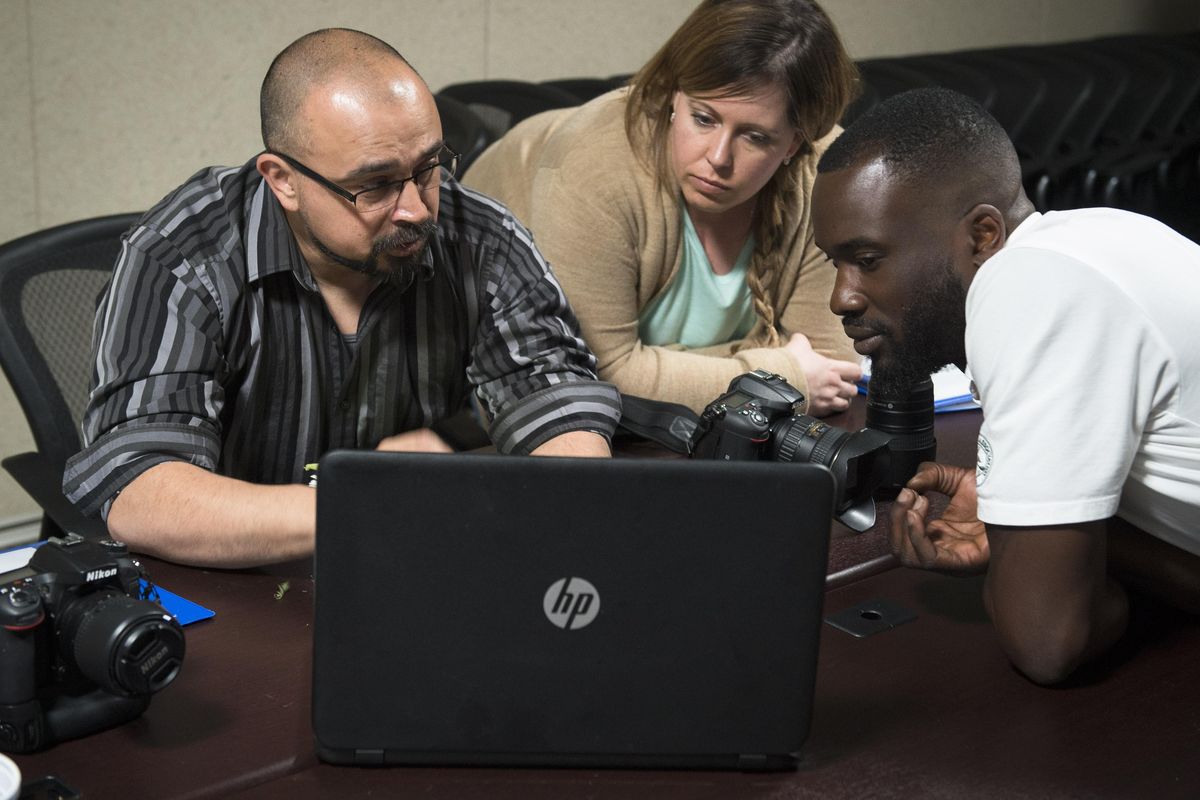LightBender photo program helps veterans find way to recovery through camera lenses

A group of war survivors is learning to cast their inner demons aside through a focus on photography.
Four vets are under the tutelage Christopher Chaffee, a Navy veteran and retired professional photographer who calls himself a “total techno photo geek.”
Chaffee, of Post Falls, served in Vietnam.
“We all step in innocent, and we come back different,” he said of the combat experience. “We live in a new normal.”
A successful expert in marketing and imaging, Chaffee, 62, decided to use his retirement years to help younger veterans readjust to civilian life after witnessing the horrors of combat.
Chaffee spent two years working with the Veterans Administration to design the therapy class, which uses photography to help vets suffering from post-traumatic stress.
“We are creating a comfort zone,” he said.
His four students comprise the inaugural class. They are grouped as a squadron of sorts. “Instead of destruction, they engage in creation,” he said.
As far as Chaffee knows, he and his colleagues are the first in the U.S. to offer a healing program using photography.
“This is a fusion of photography and therapeutic guidance,” he said.
His eight-week class is cramming two years worth of college-level instruction into that time.
They meet at the Veterans Outreach Center, a treatment facility on Mirabeau Parkway in Spokane Valley.
Army veteran Noel Pierce came back from the Middle East seeing danger in his everyday surroundings, he said.
“Everything I see is something that is going to blow me up,” the 42-year-old said of the hyper-vigilance that is one of his symptoms.
He joined the Army in 1993 and stayed for 13 years.
His post-war stress has caused him to withdraw. Photography is getting him re-engaged. Earlier this month, he went to the Armed Forces Torchlight Parade in downtown Spokane to practice his budding skills. The camera kept him calm, he said.
Pierce said he was blessed with an artistic side since his youth, and now is letting it come to fruition at the same time he overcomes the fear.
“It’s about finding the art in what you are shooting,” he said.
His goal is to become a professional photographer.
Chaffee and his supporters formed LightBenders Institute of Photography and raised enough money to buy high quality Nikon cameras and lenses for the students.
Pierce and three others are issued their own cameras for the class, and they go out on photo-taking sessions as a group.
Last week, Chaffee critiqued their work and showed them how to edit their pictures.
“This is a nice application of the rule of thirds,” he said of a basic photography tenet that divides images into a checkerboard of three-by-three squares. Balance in a photo is found by capturing an image with elements in the different spaces.
One of his students got a shot of ducklings at the Manito Park duck pond. “I like this photo,” Chaffee said. “It’s very well done.”
Some of the student images are “gallery grade,” he said.
Andrea Hesler, a 10-year Army veteran, lost at least six comrades on the battlefield in Iraq where she served on three tours.
“It’s not easy to talk about, but it’s reality,” she said.
“They were out there doing their job,” said Hesler, 38. “I know they took pride in what they did.”
Hero is a Greek word that literally means protector, defender.
Her hardest loss of all came back home when her veteran husband, Montgomery Hesler, died in an alchohol-related accident while he was coping with his own issues in 2011, she said. The Heslers had met in Iraq.
Andrea Hesler is taking a master’s degree program in social work at Eastern Washington University.
She was referred to the photography program through her therapy and then interviewed with Chaffee. She said Chaffee’s passion at that meeting brought tears to her eyes.
To her, the photography class has become “so much more than just a class,” she said.
“It became an outlet for me,” she said.
Hesler plans to use her photo skills in documenting life.
About her war experience, she said, “It definitely changes you – in good ways, too. It makes you appreciate things more – life’s little things.”
Her classmate, Earlandez Young, 26, an Air Force veteran in public affairs, had the job of photographing death scenes such as airplane crashes. He said he is enjoying the chance to photograph happier things.
Chaffee said his passion for photography began at age 12.
In the Navy, he was a photographer and photo interpreter. He went on to professional photography as a civilian and then to advanced marketing.
He raised seed money for the photo class through honorariums he received for public speaking. He also had a couple of private donors.
Chaffee wants to expand the photo class to up to 12 students and extend it to 10 to 12 weeks. He also is planning graduate seminars and classes to help his students continue to grow in their skills – what he calls post-production.
An even larger dream would be seeing the photo therapy program introduced around the country, he said.
Chaffee said the experience of Vietnam veterans is still a sad chapter in American life. He said he has long objected to the way Hollywood portrayed vets from that war.
Chaffee said it takes courage for veterans with post-war trauma to break free of the fear that haunts them.
He said he wants the public to view post-traumatic stress as a treatable injury.
“Instead of destruction, they engage in creation,” he said. “That can have a profound effect on the brain.”